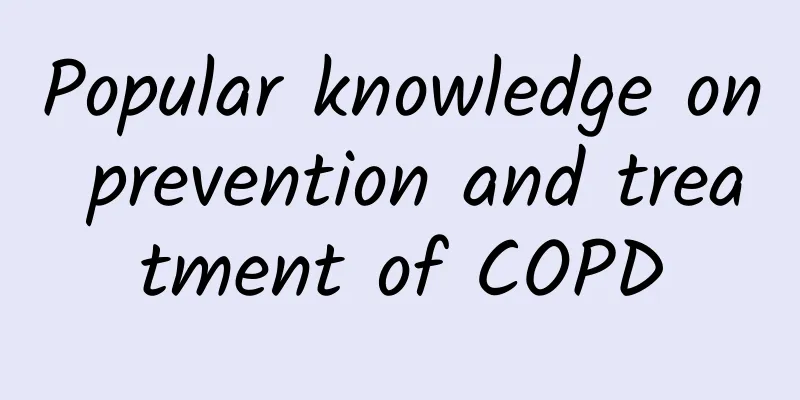Popular knowledge on prevention and treatment of COPD

|
COPD is a heterogeneous disease characterized by chronic respiratory symptoms (dyspnea, cough, sputum, exacerbations) that are due to airway (bronchitis, bronchiolitis) and/or alveolar abnormalities (emphysema), resulting in persistent and progressive airflow limitation. Causes and risk factors are divided into genetic genes (G)-environmental factors (E)-life events (T) (GETomics), which cause damage to lung tissue and change the normal development or aging process of the lungs. The main environmental exposure factors for COPD are tobacco smoke and inhalation of toxic particles and gases from indoor and outdoor air pollution, but other environmental and host factors (including abnormal lung development and accelerated aging) can also promote the occurrence. The most relevant (but rare) genetic factor for COPD is the SERPINA1 gene mutation that leads to α1 antitrypsin deficiency. Other gene mutations are associated with decreased lung function and the risk of COPD, but their corresponding effect sizes are small. Diagnostic criteria According to the definition of COPD and risk factors, a spirometry test with FEV1/FVC < 0.7 after inhalation of bronchodilators indicates the presence of incompletely reversible airflow obstruction, which is a diagnosis of COPD. Some patients may have respiratory symptoms and/or lung structural destruction (emphysema) and/or physiological abnormalities (such as decreased FEV1, gas trapping, hyperinflation, decreased diffusion capacity, and/or rapid decrease in FEV1) but no airflow obstruction (FEV1/FVC ≥ 0.7 after inhalation of bronchodilators). These patients are classified as "pre-COPD". Abnormal spirometry with preserved ratio 'PRISm' is used to screen patients with normal ratio but abnormal lung ventilation function. These two groups of people are at high risk of airflow obstruction, but not all patients will have airflow obstruction. Clinical manifestations The typical symptoms of COPD are dyspnea, limited mobility, and/or cough with or without sputum, which may be accompanied by an acute deterioration of respiratory symptoms, known as acute exacerbation of COPD, which requires prevention and treatment strategies. How to prevent COPD 1. Stay away from risk factors Smoking is the main cause of COPD. The risk of COPD in smokers is four times that of non-smokers. The prevalence of smokers over 60 years old exceeds 40%. The longer you smoke and the more you smoke, the higher your risk of COPD. Air pollution will also quietly strip you of your breathing ability. PM2.5 is one of the most common air pollutants. For every 10 micrograms increase in PM2.5, lung function decreases by 26 milliliters. Chemical gases (chlorine, nitrogen oxides, and sulfur dioxide, etc.) have irritating and cytotoxic effects on the bronchial mucosa. Particles with a diameter of 2.5-10μm in the atmosphere, namely PM2.5 and PMl0, stimulate the bronchial mucosa, impair the airway clearance function, and create conditions for bacterial invasion. 2. Early pulmonary function test Pulmonary function test is a simple, painless test that can help doctors diagnose whether you have COPD and assess the severity and prognosis of your disease. What should we do if we have COPD? Smoking cessation is a key intervention measure for all smoking COPD patients, and smoking cessation should be strongly encouraged and supported. Health education, supervision of smoking cessation and other methods can reduce the dependence of COPD patients on nicotine and improve the quality of life of patients. Recommendation: It is recommended to adopt the "5A" smoking cessation intervention plan for patients who are willing to quit smoking, and adopt the "5R" intervention measures for patients who have no intention to quit smoking to enhance their motivation to quit smoking. Smoking cessation intervention measures include behavioral intervention and drug intervention. Drug intervention (nicotine replacement therapy, bupropion, varenicline) can increase the continuous smoking cessation rate and point smoking cessation rate of COPD patients. The combination of the two has a better success rate of smoking cessation. Standardized inhalation therapy can control long-term inhalation therapy can make the drug act directly on the respiratory tract and lungs. It has good efficacy and low side effects. Therefore, it is currently considered to be the most effective way to eliminate and treat COPD. Do a good job in daily management of COPD1. Actively carry out rehabilitation training - breathing method training Breathing methods can choose one of the following or alternate between the two after proficiency2. Actively carry out rehabilitation training - physical training▷ Aerobic exercise, such as breathing gymnastics, including various gymnastics activities such as abdominal breathing, chest expansion, bending, squatting and limb activities. ▷ Common training methods include walking, running, climbing stairs, flat exercises, cycling, swimming or a combination of multiple methods, among which cycling or walking are the most commonly used exercise methods. Endurance training can improve the exercise capacity of COPD patients and improve the symptoms of dyspnea. ※ At the beginning, exercise for 5 to 10 minutes each time, 1 to 5 times a day, and extend to 20 to 30 minutes each time, 3 to 4 times a day after adaptation. The amount of exercise increases gradually from slow to fast, from small to large, according to the body's tolerance. Prevention of COPD 1. Vaccines First, it is recommended that COPD patients receive the flu vaccine of the year in a timely manner when their physical condition and condition are stable, followed by the 23-valent pneumococcal vaccine. 2. Regular and standardized use of inhaled drugs After the acute exacerbation period is relieved, COPD patients should upgrade or increase the COPD inhaled medication in a timely manner under the guidance of a doctor to ensure that the inhalation is carried out on time and in a standardized manner every day, so as to achieve the purpose of reducing the number of acute exacerbations. Specific drugs include: long-acting bronchodilators (LAMA, LABA), dual bronchodilators (LAMA LABA), inhaled glucocorticoid combined with bronchodilator (ICS LABA), triple preparations (ICS LABA LAMA). 3. Expectorant COPD patients need to strengthen sputum management, including strengthening sputum training, observing sputum properties (color, sputum volume, sputum difficulty) every day, and if sputum is not smooth or sputum properties change, they need to come to the hospital for treatment in time. Specific drugs include: myrtle oil, acetylcysteine, fudosteine, ambroxol, etc. 4. Smoking cessation education: Quitting smoking and avoiding exposure to secondhand and thirdhand smoke are important measures to control the symptoms of COPD patients. 5. Pulmonary rehabilitation training: Learn the correct abdominal breathing method and combine it with pursed lip breathing to increase the effective volume of the lungs and prevent airway collapse; through cough training, learn the correct way to cough and strengthen expectoration; perform appropriate and effective exercise training under the guidance of a rehabilitation doctor to enhance the strength of the overall muscle groups, especially the respiratory-related muscles. 6. Home oxygen therapy: After evaluation by a professional doctor, for extremely severe COPD patients with an arterial oxygen saturation of ≤88%, it is recommended to inhale oxygen for more than 15 hours a day at a flow rate of 1 to 2 liters per minute. 7. Reasonable diet: COPD is a wasting disease that causes the body to be in a state of negative nitrogen balance. Therefore, COPD patients need to increase their intake of high-quality protein, such as fish, eggs, meat, milk, etc., while ensuring adequate daily calorie supply, based on their other medical conditions. At the same time, they need to control their daily sugar intake, limit their salt intake, and appropriately increase their fat intake. Finally, patients need to supplement with a variety of vitamins, minerals, and dietary fiber to maintain good health. |
<<: [Medical Q&A] Is it better to supplement with more vitamin D?
>>: A must-read for girls who wear makeup! Beware of "makeup-induced eye diseases"!
Recommend
Can eating durian help grow endometrium?
Durian contains a lot of nutrients and is commonl...
What is the reason for purple menstruation
Menstrual blood is dark purple, which is not a bi...
Why do some people play with their phones every day and still have good eyesight? (But I can’t)
Myopia is a problem. Once you forget to wear glas...
Myopia 800 degrees closed eyes during childbirth
In today's society, many people like to use e...
Is it good for women to drink a cup of milk powder every day?
Foods like milk are not very popular in tradition...
What causes urinary pain in women?
Urgent and painful urination are manifestations o...
How to judge whether the breasts are still growing
Nowadays, many women measure their bust circumfer...
eMarketer: More than 115 million people in the U.S. will shop on their smartphones in 2019
Social networks represent only a small portion of...
Cold season: Please avoid encountering stroke
At present, stroke has become the third leading c...
What are the effects of eating bad food on the fetus during pregnancy?
I want to share that for people who love eating a...
Why is the leucorrhea abnormally yellow-green?
Abnormal leucorrhea usually refers to changes in ...
What causes adnexal cysts?
Adnexal cysts are more common in women between th...
Is it better for the placenta to be on the front or back wall of the uterus?
The placenta can appear on the front or back wall...
Food expiration date ≠ shelf life! Can expired rice, flour and oil still be eaten? The answer is surprising!
Planning and production Review丨Zhang Yu, research...









